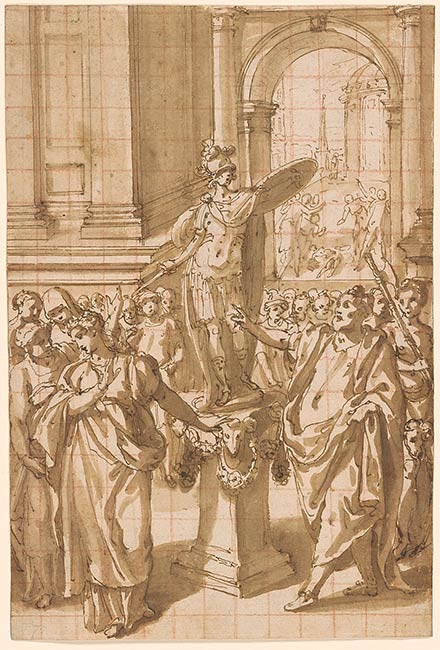Cesare Nebbia

Formerly attributed to the Genoese painter Giovanni Battista Paggi on the basis of an old inscription on the verso, the present drawing was recognized by David Lachenmann as an autograph work by Cesare Nebbia. Rhoda Eitel-Porter identified it as a highly finished study for the fresco representing St. Susanna Refusing to Sacrifice to Pagan Gods, painted on the right side wall of the apse of Santa Susanna, Rome, in 1596–97.
Founded in the fourth century, the church of Santa Susanna was entirely renovated in preparation of the Holy Year of 1600 thanks to Girolamo Rusticucci, vicar general of the dioceses of Rome and titular cardinal of Santa Susanna since 1570. The church’s renovation campaign, begun in the 1580s, included a cycle of frescoes in the apse commissioned by Rusticucci from Cesare Nebbia, one of the most celebrated artists working in Rome at the time. In order to accommodate the newly designed paintings, the old medieval mosaic that decorated the apse was removed in 1595, and at the end of January 1596 the contract for the construction of the altar was drawn up. It is likely after this date that Nebbia executed the paintings in elaborate stucco frames. The frescoes were probably finished by August 1597 when, according to the Avvisi di Roma, the church was “già del tutto abbellita” (fully decorated).1
It is in this chronological frame— between January 1596 and August 1597—that the present sheet can be placed. Squared for transfer in red chalk, the drawing was almost certainly executed during the final phase of Nebbia’s creative process. The sheet is in fact the most finished of the four surviving studies connected to the decoration of the church.2 Among these, a pen-and-wash compositional study for the Susanna Harassed by the Son of the Emperor Diocletian, in the Biblioteca Comunale degli Intronati, Siena, represents an early stage of design, as its composition was eventually reworked almost completely. Less drastically, Nebbia revised the Morgan drawing of St. Susanna Refusing to Sacrifice to Pagan Gods. In comparison with the final fresco, the changes focus mostly on the architecture in the background, where the epilogue of the story is depicted: the statue that Susanna was forced to worship is found shattered on the ground. The crucial episode of the narrative, Susanna refusing to sacrifice to the pagan idol, is still in the foreground, but while the statue in the Morgan drawing represents a soldier dressed in armor with sword and shield (probably Mars, god of war), in the fresco it becomes a small statuette of Jupiter mounted on a tripod.
Some of Nebbia’s corrections to the design, possibly suggested by Cardinal Rusticucci during the revision of the sheet, were inspired by the story of St. Susanna as it was narrated in the Historia delle Stationi di Roma (1588) by Pompeo Ugonio and integrated with elements derived from the Historia delle Sante Vergini Romane (1591) by Antonio Gallonio, and from the Annales Ecclesiastici (1588–1607) by Cesare Baronio.3 While in his text Ugonio mentions the statue of Jupiter, Baronio recalls the detail of the tripod (“After this one [Maximianus] visits her; he brings over a tripod; he commands that she sacrifices with incense to the image of Jupiter that he built.”)4 These texts were produced as a direct response to charges lodged by Protestants against Catholic doctrine, and the painters adopted them as precise manuals for their devotional compositions. Images served as powerful sources of Catholic propaganda to visually document and therefore demonstrate the authority of the “true” Church.
The St. Susanna Refusing to Sacrifice to Pagan Gods constitutes a fundamental point of reference in Nebbia’s graphic oeuvre. Completed at the peak of his career, when Nebbia had worked in some of the major sites of the Eternal City and its surroundings—in the basilica of St. Peter (1578–83), in the Oratorio del Gonfalone (1576–77), and in the cathedral of Orvieto—the drawing encapsulates all the main characters of the painter’s mature style and reflects his dependence on the entire Roman cinquecento painting tradition. A neo-Raphaelesque symmetry is combined here with the monumental presence of the figures and their solemn gestures inherited from the art of Girolamo Muziano (see 1979.6), with whom Nebbia broadly collaborated at the beginning of his career before becoming an artist of note in Rome.
—MSB
Footnotes:
- As cited in Zuccari 2004, 38.
- The study for St. Susanna Brought to the Sky by the Angels is in the Rijksmuseum, Amsterdam, inv. 1952.29; the preparatory drawings for the Playing Angels and for Susanna Harassed by the Son of the Emperor Diocletian are in the Biblioteca Comunale degli Intronati, Siena, inv. S.III.8, 14r(a) and S.III.2, 7(b). See Eitel-Porter 2009, 202, 204.
- In a paper devoted to “Die Fresken in S. Susanna und der Beginn das Barock,” presented at the Biblioteca Hertziana, Rome, 24 February 2000, Rhoda Eitel-Porter further elaborated on the origins of the St. Susanna cycle discussed in her 1997 dissertation.
- “Finalmente gli mandò una statuetta di Giove, facendogli intendere che ò quella adorasse ò si risolvesse à morire”; Ugonio 1588, 189v. “Abit ille, convenit eam: admovet tripodem: iubet ut thura offerat Iovis, quod statuarat, simulacro”; Baronio 1588–1607, 2:655.
Inscription: On the top of the verso, 61 N.31 has been written in pen and brown ink. In graphite, on the bottom lower right, II / 700 / No. 57 lue / Gio. Batt. Paggi / 1554-1627 Sienna / 7221 / Edl.lee / Poggi has been inscribed by Scholz.
Rhoda Eitel-Porter and and John Marciari, Italian Renaissance Drawings at the Morgan Library & Museum, New York, 2019, no. 124.
Selected references: London 1996, no. 7; Eitel-Porter 1997, 193-97; Zuccari 2004, 40-41, 71; Eitel-Porter 2009, 137-38, 190.
Flavia Ormond Fine Arts Limited, Italian Old Master Drawings 1500-1850, exh. cat., 1999, no. 7, repr.
Rhoda Eitel-Porter, Der Zeichner und Maler Cesare Nebbia 1536-1614, Munich, 2009, pp. 137-138, 190, fig. 167.